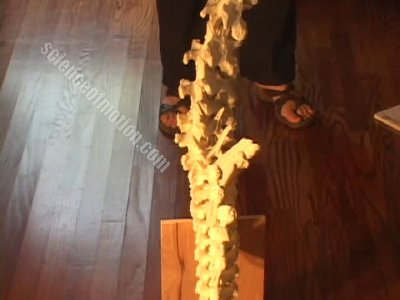The Miracles of the Science of Motion2
The Miracles of the Science of Motion
The miracles of the Science of Motion are not solely about rehabilitations. They are also about performances.
(video is at bottom of page)
 This is not the vertebral column of the horse that you can see on the video, but this specimen shows the thoracolumbar spine abnormality that leaded this horse to absolutely refuse any water jump. He was a “would be” Grand Prix jumper in the sense that he had the power, the stamina and courage to fly above the technical difficulties of a Grand Prix Jumping course, but he never finished any course until he came at the Science of Motion, as he never jumped the river.
This is not the vertebral column of the horse that you can see on the video, but this specimen shows the thoracolumbar spine abnormality that leaded this horse to absolutely refuse any water jump. He was a “would be” Grand Prix jumper in the sense that he had the power, the stamina and courage to fly above the technical difficulties of a Grand Prix Jumping course, but he never finished any course until he came at the Science of Motion, as he never jumped the river.
As it is the case in 90% of the times, it was a physical issue which was approached as a behavior problem. However, after more than a year of unsuccessful attempts, the rider, who was also the owner, explored the thought that a physical issue was possibly the problem. This is when the horse came at the Science of Motion training center.
The horse was quite good over high jumps and very poor over low jumps. He was not disturbed by the landing of a 6 feet oxer, but he anticipated the landing of a low and wide jump such as a river. He traveled and performed with a thoracolumbar spine very crooked, which could explain intense loading of the leading front leg at the landing as well as severe pain in the thoracic vertebrae. The question was why the crookedness did not seem to induce pain at the landing of higher jumps. It was a considerable difference between the horse’s style over higher jumps, which was quite good, and the style of the same horse over lower jumps, which was very poor. This suggested that the athletic demands of higher jumps and in particular the longitudinal flexion of the thoracic spine, recreated a transient alignment of the thoracolumbar spine allowing less painful landing. Based in this working hypothesis, it was rational to think that correcting the back muscles imbalance causing lateral bending and inverted rotation would allow painless landing of lower jumps and this is word for word what happened.
In line with the overly simplistic thinking of most training techniques the advice commonly given to the rider was, “only jump big jumps”. This is the primitive thinking of behavior theories. The horse flew effortlessly over 6 feet oxers, but just to annoy the rider, it does not jump the river. Another one turns left but just to aggravate the rider, the horse refuses to turn right. He likes halt but not want to back up. Running away from the predator, forward movement, is the horse’s most basic survival instinct, but because it is “lazy”, the horse refuses moving forward. Come on, if you think about it, these behavior theories are ridiculous.
In two months of corrective gymnastic on the flat the back muscle imbalance was corrected and proper coordination was created. Once the horse performed on the flat, at the walk, trot and canter with a functional thoracolumbar spine, the gymnastic was extended over low and wide jumps. In one month, the horse figured that keeping over the jump the body coordination created on the flat, rendered the jumping performance easy and pain free. It was time to face the truth.
The river was set in the middle of the ring, blue tarp, water contrasting strongly with the white sand. The first attempt over the river was recorded on video, first the warm up and then the fly over the river.
We have received horses refusing entering the show ring, bucking between the jumps. One added one stride in the middle of a in and out and amazingly was still capable to clear the second jump. This one had difficulties turning right at the landing of a jump. This one’s balance was perturbed by the lead changes. This other one scared himself jumping too high, etc., etc. Each time it was a dysfunction in the vertebral column mechanism. Each time, correcting the muscular issue “corrected the behavior.”
Jean Luc Cornille
Science Of Motion



 twitter
twitter facebook
facebook google
google stumbleupon
stumbleupon pinterest
pinterest